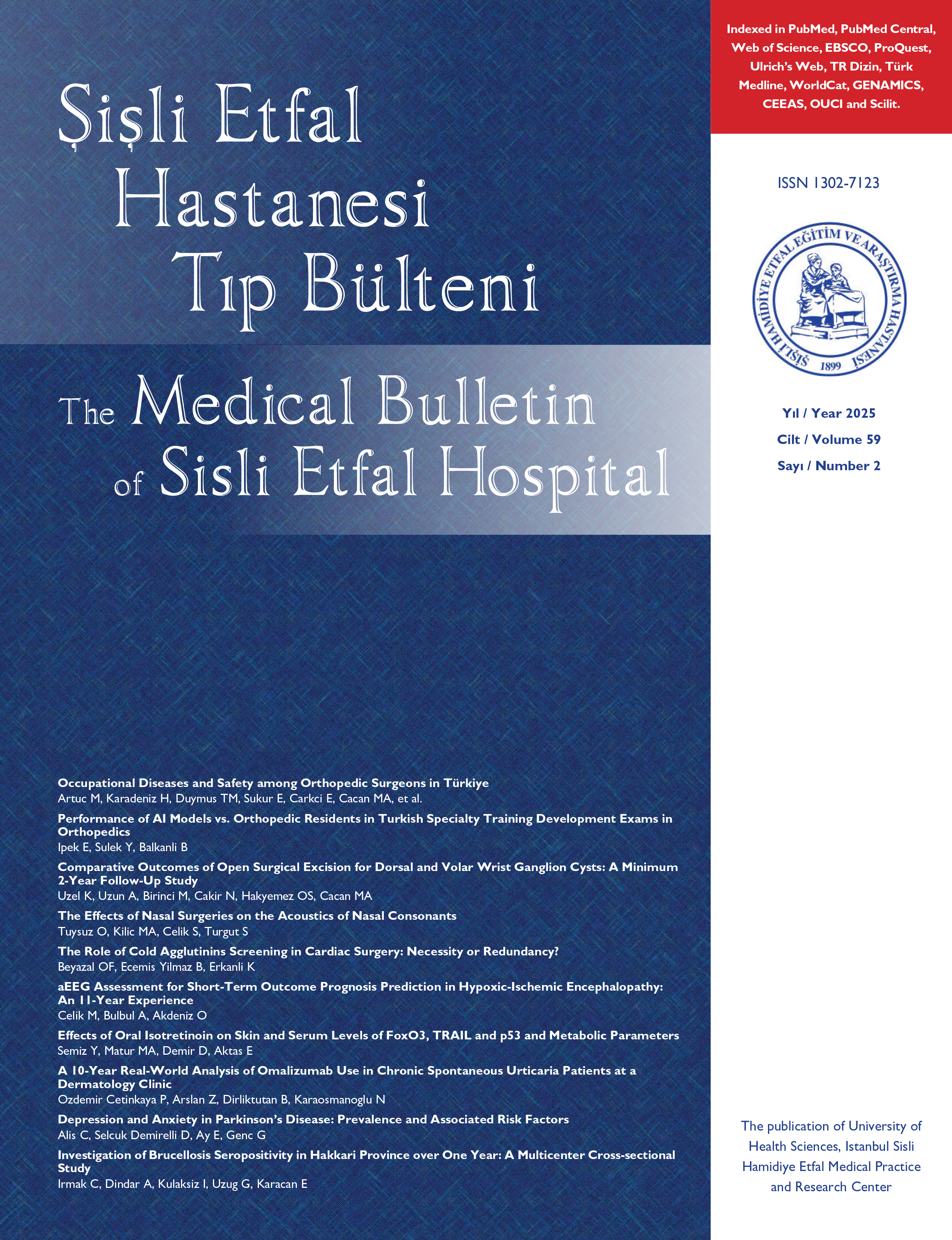
HPV 16 +Koenfeksiyon, Tek Başına HPV 16'ya Göre Servikal Patoloji Üzerinde Daha Kötü Bir Etkiye Sahip midir?
Aysun Alcı1, Necim Yalcın2, Mustafa Gokkaya3, Gülsüm Ekin Sarı4, Harun Resit Turkmenoglu4, Isin Ureyen4, Tayfun Toptas41Kahramanmaraş Necip Fazıl Şehir Hastanesi, Jinekolojik Onkoloji Kliniği, Kahramanmaraş, Türkiye2Batman Eğitim ve Araştırma Hastanesi Jinekolojik Onkoloji Bölümü, Batman, Türkiye
3Gaziantep Şehir Hastanesi Jinekolojik Onkoloji Bölümü, Gaziantep, Türkiye
4Sağlık Bilimleri Üniversitesi Antalya Eğitim ve Araştırma Hastanesi, Jinekolojik Onkoloji Bölümü, Antalya, Türkiye
Amaç: Bu çalışmanın amacı, HPV16 enfeksiyonuna ek olarak diğer HPV genotiplerinin varlığının patolojik sonuçlar üzerinde olumsuz bir etkisi olup olmadığını değerlendirmektir.
Yöntem: Bu retrospektif çalışma, 2017 ile 2025 yılları arasında Antalya Eğitim ve Araştırma Hastanesi Jinekolojik Onkoloji Polikliniğinde takip edilen hastaların verileri kullanılarak gerçekleştirilmiştir. HPV16 pozitif olup buna ek olarak diğer HPV genotiplerini de taşıyan hastalar çalışmaya dahil edilmiştir. HPV genotiplendirmesi Hybrid Capture 2 ve CLART Genomica sistemleri kullanılarak yapılmıştır.
Bulgular: Toplam 2.700 HPV (İnsan Papilloma Virüsü) pozitif kadının 524ü yalnızca HPV16 pozitifken, 358i hem HPV16 hem de diğer genotiplerle birlikte pozitifti. Histopatolojik sonuçlar (CIN 2/3, HSIL ve invaziv kanser dahil) iki grup arasında anlamlı bir fark göstermemiştir (p>0.05). Ancak, kolposkopide saptanan anormal bulgular, eş enfeksiyon (ko-enfeksiyon) grubunda istatistiksel olarak daha yaygın bulunmuştur (p=0.037). Sigara içimi, ko-enfeksiyon için 1.27 kat artmış risk ile ilişkili bulunmuştur (p=0.026).
Sonuç: Bu çalışmanın bulguları, yüksek dereceli servikal patolojilerin gelişiminde esas belirleyicinin HPV16 olduğunu ve diğer yüksek riskli HPV tiplerinin varlığının histopatolojik sonuçları anlamlı şekilde kötüleştirmediğini göstermektedir. Sonuçlar, serviks kanseri tarama süreçlerinde risk temelli bir yaklaşımın önemini desteklemekte ve HPV16 pozitif bireylerde erken tanı ve önleyici müdahalelere öncelik verilmesi gerektiğini vurgulamaktadır.
Does Co-Infection With HPV 16 Have a Worse Effect on Cervical Pathology Than HPV 16 Alone?
Aysun Alcı1, Necim Yalcın2, Mustafa Gokkaya3, Gülsüm Ekin Sarı4, Harun Resit Turkmenoglu4, Isin Ureyen4, Tayfun Toptas41Department of Gynecologic Oncology, Kahramanmaras Necip Fazıl City Hospital, Kahramanmaras, Turkiye2Department of Gynecologic Oncology, Batman Training and Research Hospital, Batman, Turkiye
3Department of Gynecologic Oncology, Gaziantep City Hospital, Gaziantep, Turkiye
4Department of Gynecologic Oncology, Health Scıences Unıversıty Antalya Training and Research Hospital, Antalya, Turkiye
Objectives: The aim of this study is to evaluate whether the presence of other HPV genotypes in addition to HPV16 infection has a negative effect on pathological outcomes.
Methods: This retrospective study was conducted using data from patients followed up at the Gynaecological Oncology Clinic of Antalya Training and Research Hospital between 2017 and 2025. Patients who were HPV16-positive and also carried other genotypes in addition to HPV16 were included in the study. HPV genotyping was performed using the Hybrid Capture 2 and CLART Genomica systems.
Results: Of the total 2,700 HPV (Human Papillomavirus) -positive women, 524 were HPV16-positive only, while 358 were positive for HPV16 along with other genotypes. Histopathological results, including CIN 2/3, HSIL, and invasive cancer, did not show significant differences between the two groups (p>0.05). However, abnormal colposcopy findings were statistically more prevalent in the co-infection group (p=0.037). Cigarette smoking was associated with a 1.27-fold increased risk for co-infection (p=0.026).
Conclusion: The findings of this study indicate that HPV16 is the primary determinant in the development of high-grade cervical pathology, and the presence of other high-risk HPV types does not significantly worsen histopathological outcomes. The results support the importance of a risk-based approach in cervical cancer screening processes and emphasize the need to prioritise early diagnosis and preventive interventions in HPV16-positive individuals
Makale Dili: İngilizce



















